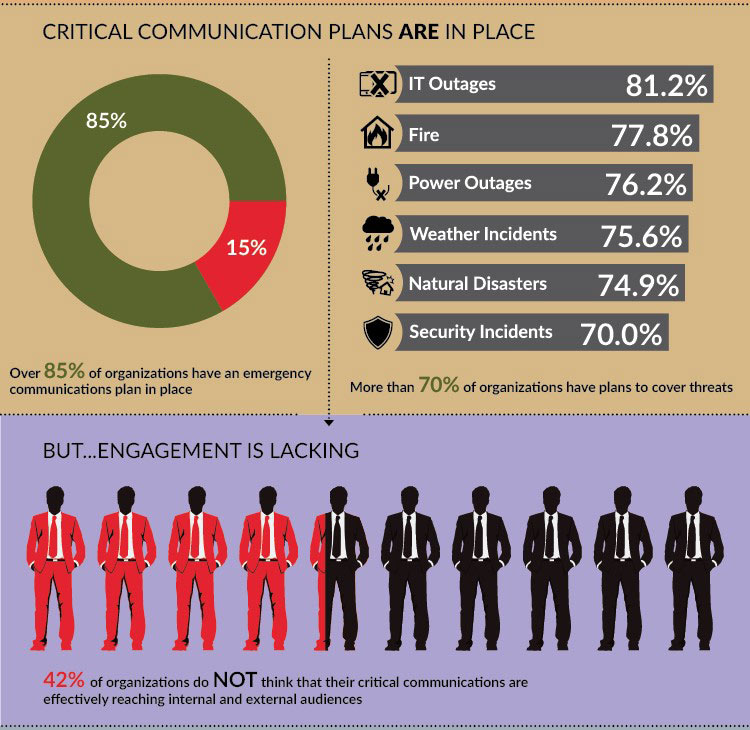This brief guide shows exactly how you can save the people for whom you are responsible.
Your personal team can be heroes or scapegoats. Preparation for an emergency is essential and a strong communication plan is the backbone. Please read and implement this guide, make adjustments for your situation, then feel free to share it with your appropriate staff.
On the morning of September 11, 2001, businesses occupying the World Trade Center buildings in New York City fell prey to the worst terrorist attack in U.S. history. In the aftermath of the disaster, it was found that a lapse in communication regarding evacuation led to a significant loss in life.
Communication is one of the most easily overlooked parts of a business emergency plan. It's imperative that you and your employees establish communication expectations for various emergency scenarios so that everyone knows how to react. This plan needs to be regularly reviewed, updated as needed, and include both internal and external communication policies.
Internal Emergency Communication
When communicating internally during an emergency, there are numerous ways to alert employees of the specific situation, and convey instructions to evacuate the building and relocate at assembly points. Some of the same communication methods can be used to give updates on the status of the situation and notification of when it's safe to return to work.

Full infographic at everbridge
External Emergency Communication
External emergency communications should also fit into your business emergency plan. You'll want to be able to notify family members of an injury or death, discuss the disaster with the media, and provide status information to clients and stakeholders.

Full infographic at Young Upstarts
Methods of Communication
Telephone
One of the first tools to turn to in an emergency is the telephone. Before an emergency occurs, assemble a database of contact numbers for all employees and clients. Include names and at least two numbers at which they can be reached. It is vital that all lists are updated with the most recent contact information at least once a month.
If your telephone service is still available during the emergency(*), activate your telephone notification chain and forward instructions to all employees on your team. If you have a small business, it might be easier and more cost effective to forgo a telephone notification service and simply text all employee numbers in your database with an emergency message. Emergency messages can also be sent to clients and stakeholders to let them know of a temporary interruption in business.
*If your company uses a VoIP service and your power is out or your internet connection is down, be aware that your telephones may not work. Consider installing a backup power supply, maintaining a traditional phone line, or having a wireless phone as a backup. Your disaster communication plan can also incorporate more than one of these solutions into its entire framework to hedge against the risk of failures of one or the other, such as the loss of internet connectivity or the failure of traditional phone lines.
PA System
Businesses equipped with a PA system can utilize this important tool during an emergency to broadcast evacuation procedures. Since it's possible for PA systems to play pre-recorded messages, there is no need for an operator to risk their safety by staying to relay instructions. However, a PA system is only effective as a business communication solution for relaying messages to those on-site (or on sites that have PA systems installed), revealing its limited utility. PA systems are best leveraged in concert with other protocols.
Two Way Radio
Because they are independent from the grid, two-way radios are the best option for coordinating evacuation efforts, relaying important medical information, and communicating threat assessments. Two way radios offer instant communication (delete) and work even when phone lines are clogged and the internet is down. An additional feature of two way radios are their ability to facilitate group-calls quickly and effectively.
There are two types of radios to consider:
- Conventional -- Users choose and operate on one channel at a time.
- Trunked -- The system automatically picks the physical radio frequency channel and users carry simultaneous conversations privately on one channel.
Internet
The Internet is the perfect backup communication method to use when phone systems fail. Email is a great way to alert employees and clients of a dangerous situation at the office, and what they should expect after a disaster scenario. Since 26% of people don't check their work email while at home, it's important to have a personal email on file for each employee to use in cases of emergency. The use of internet-connected communication systems is also an effective failsafe in the event that PA systems or telephone lines have been incapacitated for any reason.
Businesses can also use social media to share what's happening during and after an emergency. Both Facebook and Twitter are channels people often turn to in order to receive vital information -- your employees and clients are no exception.
News Media
Since the image of a business can be impacted by public perceptions of the handling of an emergency, it's important to respond promptly, accurately, and confidently the days that follow. If the incident is serious enough, there may be numerous requests for information from both local and national media. Because of this, it's essential to determine in advance who will speak to the news media and prepare that spokesperson with talking points.
Improving Business Communication Solutions with Redundant Backups
Ensuring that your business is prepared to effectively respond to threats and challenges, as well as to efficiently communicate internally, is about more than just having the protocols in place. It also requires you to be prepared with physical business communication systems as detailed here. Redundant communications systems can also help protect your business and its employees against unforeseen occurrences, such as loss of network access or power outages. Developing a holistic communications system complete with redundant failsafes will uphold a better overall measure of disaster preparedness. Explore our emergency radios for communications and body cameras for recording and protection, and contact us if you have any questions and we will help you find your radio.
Preparation Lists
Use the following lists from Tech Target to prepare your business for all aspects of an emergency.
What you need before the emergency
- Step-by-step emergency communications plan
- List of internal contacts
- List of external contacts
- Special forms, such as call logs to track inquiries from the media and others, an emergency contact directory, an incident description report, a bomb threat report, etc.
- Pre-written documents such as press releases, initial announcements and follow-up statements
- Location for media to convene, with provided power, network access, television monitors, briefing area and work area
- Trained emergency communications team
- Trained company spokesperson
- Technology for rapidly disseminating emergency information to employees, stakeholders, suppliers, clients, government agencies, and other external entities
- Company policy with regard to all aspects of emergency communications
What you need during the emergency
- Confirmed location of all employees
- Updated status reports on the incident
- List of internal people contacted
- List of external organizations contacted
- List of resources needed, obtained and returned
- Actions taken during the incident
- Updated emergency communications plan
- Problems encountered and how they were resolved
- Persistent problems that require additional help
- Narrative of the incident: what happened, what was done, the results and the outcomes
What you need after the emergency
- Confirmation that all employees have returned to work safely
- Final status reports on the incident
- Complete list of internal people contacted
- Complete list of external organizations contacted
- Complete list of resources needed, obtained and returned
- Actions taken to end the incident
- Documented and annotated emergency communications plan
- Complete list of problems encountered and how they were resolved
- Completed narrative of the incident: what happened, what was done, the results and the outcomes
This guide is meant to be used as a brief overview of an emergency communications plan for your business. To find more information on developing and implementing a plan, check Ready.gov.
